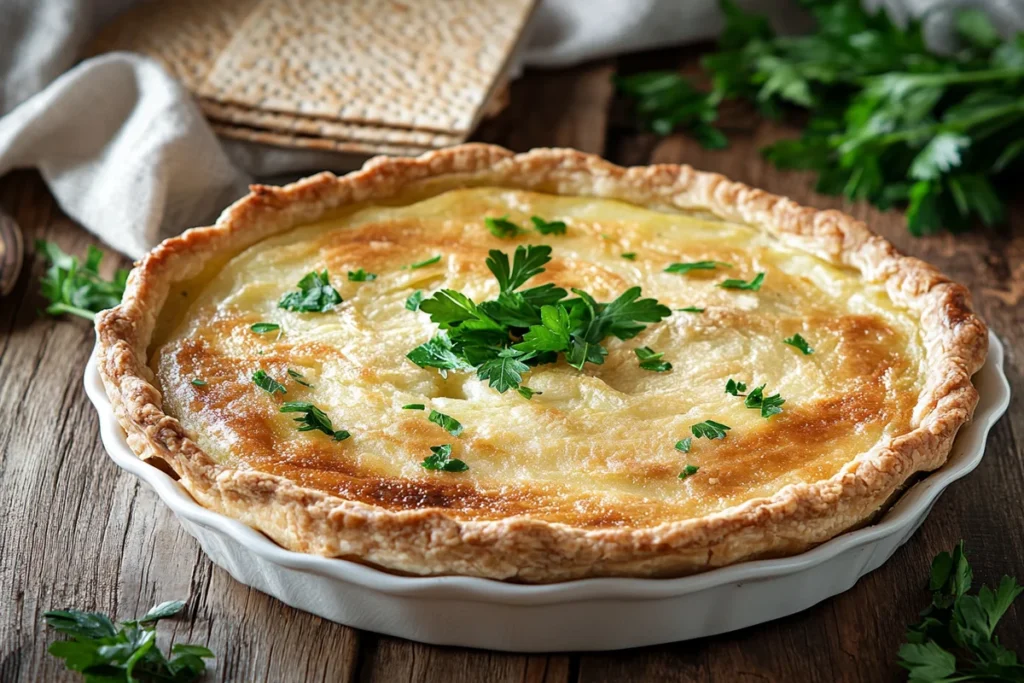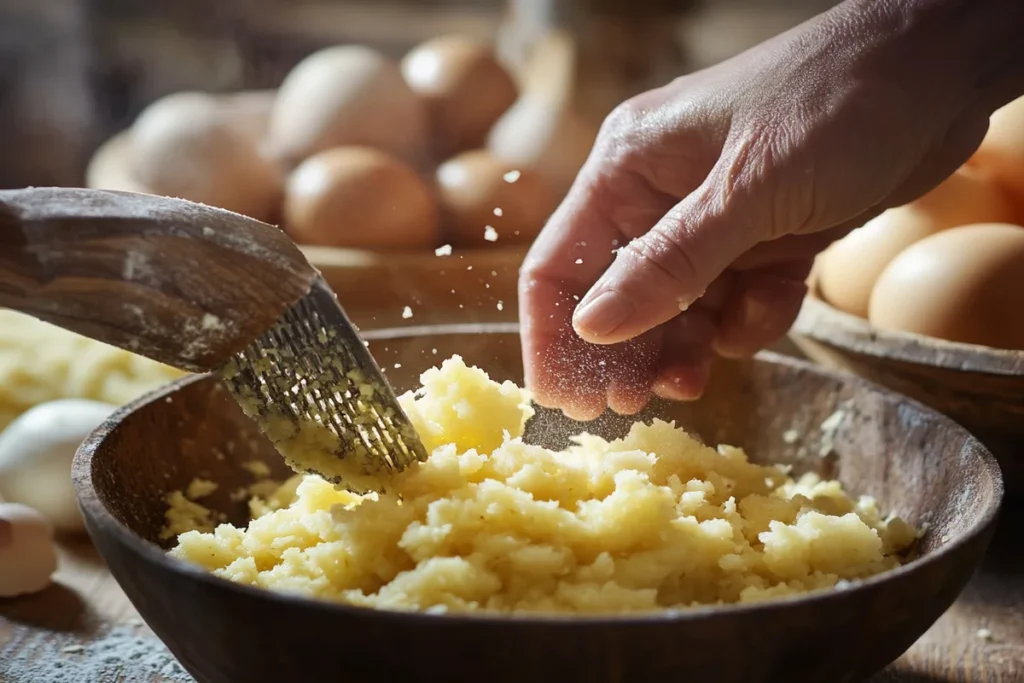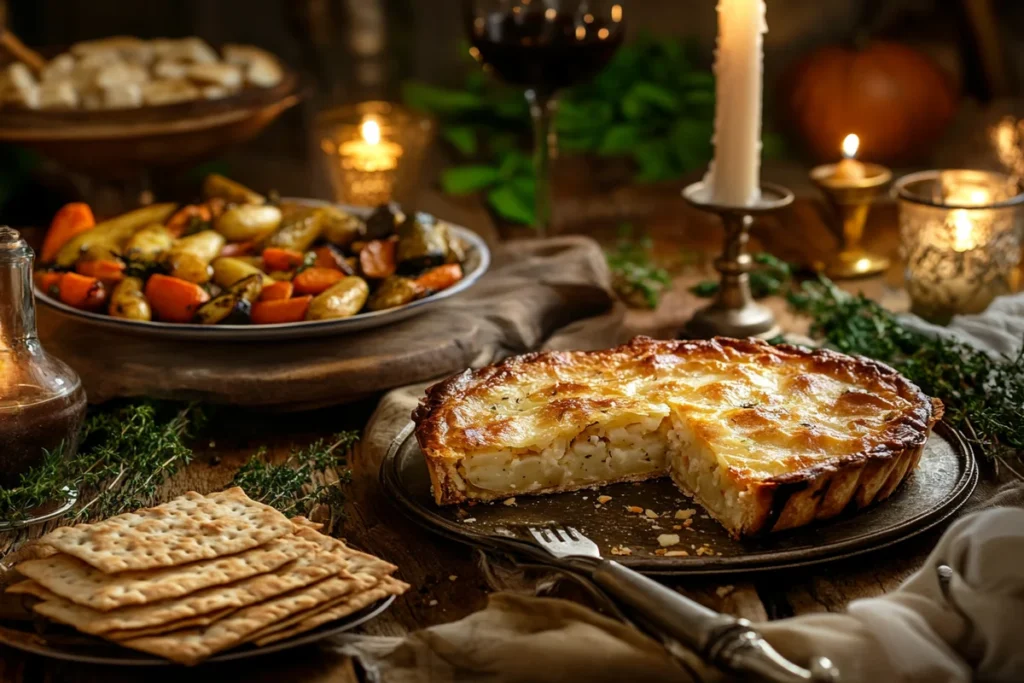
Passover is a time of tradition, family gatherings, and, of course, delicious food. While matzo takes center stage, potatoes play a crucial role in creating hearty, satisfying dishes that are both kosher for Passover and irresistibly comforting. One such dish is Passover Potato Pie—a versatile, savory treat that can be enjoyed in various forms, from crispy and golden to soft and creamy.
In this guide, we’ll explore everything you need to know about this delicious dish. We’ll start with its origins and significance, then dive into classic and creative recipes, serving ideas, and essential cooking tips. Whether you’re looking for a traditional recipe or a unique twist, this article will equip you with everything you need to perfect your Passover Potato Pie. Let’s dig in!
What is Passover Potato Pie?
Passover Potato Pie is a hearty, flavorful dish made primarily from potatoes, eggs, oil, and matzo meal. It can be baked into a crispy, golden pie, layered like a casserole, or even molded into patties for an alternative take. Unlike potato kugel, which is often softer inside, this dish can range in texture from fluffy to firm, depending on how it’s prepared.
The Significance of Potatoes in Passover Cooking
During Passover, Jewish dietary laws prohibit chametz—leavened bread and grains that have fermented. This means staples like wheat, barley, and rye are off the table, making potatoes an essential ingredient in many Passover recipes.
Not only are they kosher for Passover, but they’re also incredibly versatile. Whether mashed, grated, or baked, potatoes provide the perfect base for filling, comforting dishes that don’t rely on grain-based products. That’s why Passover Potato Pie is a staple in many Jewish homes during the holiday.
Origins and Variations of Passover Potato Pie
While potato-based dishes are common across Jewish communities, Passover Potato Pie has roots in different traditions:
- Ashkenazi Jewish Cuisine: Similar to potato kugel, this version of the dish is typically baked in a casserole dish and features a crispy, golden-brown top.
- Sephardic Jewish Cuisine: Variants like Maakouda, a Moroccan potato pie, are often seasoned with herbs and spices, sometimes layered with vegetables or meat.
- Modern Adaptations: Today, many people experiment with adding sweet potatoes, carrots, onions, or even dairy-free alternatives to create new and exciting flavors.
How It Differs from Other Passover Dishes like Kugel and Mina de Matzah
It’s easy to confuse Passover Potato Pie with other popular dishes like potato kugel or mina de matzah, but there are key differences:
- Potato Kugel: Often softer, sometimes more like a pudding, and baked in a deep dish.
- Mina de Matzah: A Sephardic dish made with matzo instead of potatoes, resembling a layered savory pie.
- Passover Potato Pie: Can be crispy or soft, depending on preparation, and can include additional vegetables or even proteins.
This unique dish bridges the gap between traditional and modern Passover cuisine, offering a delicious way to enjoy potatoes while keeping within kosher guidelines.
Traditional Passover Potato Pie Recipe

If you’re looking for more traditional recipes, check out Our Delicious & Authentic Halal Recipes for more inspiration!
Nothing beats a classic Passover Potato Pie—crispy on the outside, soft on the inside, and packed with comforting flavors. This traditional recipe follows kosher guidelines and is perfect for your Passover table.
Essential Ingredients for a Classic Recipe
To make a traditional Passover Potato Pie, you’ll need simple ingredients that stay true to the dish’s origins:
- 6 large potatoes (Russet or Yukon Gold work best)
- 1 medium onion, finely chopped
- 4 large eggs
- ½ cup olive oil (or another kosher-for-Passover oil)
- ½ cup matzo meal (for structure)
- 1 teaspoon salt
- ½ teaspoon black pepper
- Optional: garlic powder, paprika, or fresh herbs for extra flavor
Step-by-Step Cooking Instructions
- Preheat and Prepare: Set your oven to 375°F (190°C). Grease a baking dish or pie pan with olive oil.
- Grate the Potatoes: Peel and grate the potatoes using a box grater or food processor. Place them in a bowl of cold water to prevent browning.
- Squeeze Out Moisture: Drain the potatoes and use a cheesecloth or clean towel to squeeze out excess liquid. This step ensures a crispy texture.
- Mix Ingredients: In a large bowl, combine the grated potatoes, chopped onions, eggs, olive oil, matzo meal, salt, and pepper. Mix well.
- Bake to Perfection: Pour the mixture into the prepared dish, smoothing out the top. Bake for 45-50 minutes, or until golden brown and crispy on the edges.
- Serve and Enjoy: Let the pie rest for 10 minutes before slicing. Serve warm with your favorite Passover sides.
Tips for Achieving the Perfect Texture and Flavor
- For extra crispiness, brush the top with a little more olive oil before baking.
- Want a fluffier texture? Beat the eggs well before adding them to the mixture.
- Make it ahead! You can prepare Passover Potato Pie in advance and reheat it before serving.
Now that you’ve mastered the traditional version, let’s get creative with some unique variations!
Variations of Passover Potato Pie
If you’re looking to spice things up, there are plenty of ways to customize Passover Potato Pie. From Moroccan-inspired flavors to gluten-free twists, these variations will take your holiday meal to the next level.
Moroccan-Style Potato Pie (Maakouda) with Dandelion
A favorite in Sephardic Jewish cuisine, Maakouda is a spiced potato pie often served during Passover. This version features dandelion greens for a rich, earthy flavor.
Ingredients:
- 6 potatoes, boiled and mashed
- 1 cup finely chopped dandelion greens
- 2 cloves garlic, minced
- 1 teaspoon ground cumin
- ½ teaspoon turmeric
- 2 eggs
- ½ cup matzo meal
- Olive oil for frying
Instructions:
- Mix mashed potatoes with dandelion greens, garlic, cumin, and turmeric.
- Stir in eggs and matzo meal until well combined.
- Shape into a pie or smaller patties.
- Fry in olive oil until crispy, or bake for a healthier option.
Passover Shepherd’s Pie: A Hearty Meat Option
If you want a more filling version, turn Passover Potato Pie into a Shepherd’s Pie by layering it with ground beef or lamb.
How to Make It:
- Cook 1 pound of ground beef or lamb with onions and garlic.
- Season with salt, pepper, and paprika.
- Spread the meat mixture into a baking dish, then top with the traditional Passover Potato Pie mixture.
- Bake at 375°F for 40 minutes, or until golden.
Vegan and Gluten-Free Adaptations
For a vegan-friendly version, replace eggs with a mixture of mashed sweet potatoes and a flaxseed egg (1 tbsp flaxseed + 2.5 tbsp water).
For a gluten-free option, simply swap matzo meal with ground almonds or potato starch.
Adding Carrots and Other Root Vegetables for Flavor
Want to give your Passover Potato Pie a natural sweetness? Try mixing in grated carrots, parsnips, or sweet potatoes. These root veggies add color, nutrients, and a subtle earthy sweetness.
Serving and Pairing Ideas for Passover Potato Pie

A perfectly baked Passover Potato Pie deserves the right pairings to make it shine. Whether served as a side dish or the star of the meal, the right accompaniments will enhance its flavor and texture.
Perfect Side Dishes and Complements
Pairing Passover Potato Pie with the right side dishes can elevate the meal. Some great options include:
- Roasted Vegetables: Carrots, zucchini, or asparagus add color and a hint of sweetness.
- Matzo Ball Soup: A warm, comforting broth pairs beautifully with the crispy, golden crust.
- Fresh Salads: A light cucumber and dill salad or a citrusy fennel salad balances the richness of the pie.
- Brisket or Roast Chicken: If serving as a side, a tender brisket or roasted chicken makes the perfect match.
Pairing with Kosher Wines for Passover
A glass of kosher-for-Passover wine is a great way to complement your meal. Consider these pairings:
- Cabernet Sauvignon: Its bold flavors go well with a hearty Passover Potato Pie.
- Chardonnay: A crisp white wine cuts through the richness, especially if the pie has cheese.
- Sweet Kosher Wine: If you prefer something traditional, a lightly sweet wine can contrast with the savory flavors.
How to Present Your Dish for Seder Night
Presentation matters, especially for a holiday meal. Try these tips to impress your guests:
- Use a Pie Dish with a Crispy Crust: A round pie dish makes it look elegant and traditional.
- Garnish with Fresh Herbs: Sprinkle chopped parsley or dill for a pop of color.
- Serve in Individual Portions: Cutting the pie into neat slices or making mini potato pies adds a special touch.
Now that you know how to serve your dish, let’s talk about common mistakes to avoid.
Common Mistakes to Avoid When Making Passover Potato Pie
Even a simple dish like Passover Potato Pie can go wrong if you’re not careful. Here are some common mistakes to watch out for.
Using the Wrong Type of Potatoes
Not all potatoes are created equal! For the best results:
- Use starchy potatoes like Russets for a fluffy texture.
- Avoid waxy potatoes like red potatoes, which can make the pie too dense.
Over or Under-Cooking Issues
Cooking times are crucial for getting the perfect texture:
- Undercooked Pie: If your pie is too soft in the middle, bake it longer at a lower temperature.
- Overcooked and Dry: If it turns out too dry, add an extra egg or a bit more oil next time.
Making It Too Dry or Too Mushy
Striking the right balance is key. Avoid these pitfalls:
- Too dry? Add more eggs or oil to keep it moist.
- Too mushy? Be sure to drain grated potatoes well before mixing.
Frequently Asked Questions (FAQs)
Still have questions about making the perfect Passover Potato Pie? You’re not alone! Here are answers to some of the most commonly asked questions.
Can I Make Passover Potato Pie in Advance?
Absolutely! Passover Potato Pie can be made ahead of time and stored in the refrigerator for up to three days. To keep it fresh:
Let it cool completely before wrapping it tightly in foil or plastic wrap.
Reheat it in the oven at 350°F (175°C) for about 15–20 minutes to restore its crispy texture.
Avoid microwaving, as it can make the crust soggy.
If you need to freeze it, wrap it well and store it for up to a month. Just thaw overnight before reheating.
What’s the Difference Between Potato Pie and Kugel?
While Passover Potato Pie and potato kugel share similar ingredients, they have distinct textures and preparation methods:
Potato Kugel: Usually softer, fluffier, and baked in a deep dish. The inside remains moist, while the top forms a golden crust.
Passover Potato Pie: Can be crispier and firmer, often baked in a pie dish or pan for a structured shape.
How Can I Make a Lighter Version?
If you’re looking for a healthier alternative, try these swaps:
Use sweet potatoes instead of white potatoes for extra nutrients.
Swap out some of the oil for applesauce or mashed avocado to reduce fat.
Try baking in muffin tins for pre-portioned servings that cook faster and use less oil.
Can I Use Sweet Potatoes Instead of White Potatoes?
es! Sweet potato Passover Pie is a delicious alternative. It has a naturally sweet flavor that pairs well with warm spices like cinnamon and nutmeg.
If using sweet potatoes, keep in mind:
They have more moisture, so you may need to reduce the eggs slightly.
The pie might need an extra 5–10 minutes in the oven to firm up.
Now that we’ve answered your top questions, let’s wrap up with some
Final Thoughts on Passover Potato Pie
Passover Potato Pie is a dish that brings tradition and flavor together in a comforting way. Whether you make it classic, add a modern twist, or try a different variation, it’s a must-have for any Passover table.
Why You Should Try It This Passover
- It’s easy to make with simple, wholesome ingredients.
- It’s versatile, allowing for creative variations like vegan, gluten-free, or meat-filled options.
- It pairs well with other Passover recipes, making it a perfect side or main dish.
A Timeless Tradition
From Ashkenazi-style potato kugels to Sephardic-inspired potato pies, this dish has been enjoyed for generations. Whether you’re making it for a Seder dinner or just a comforting holiday meal, it’s a recipe that will keep everyone coming back for more.
So, what are you waiting for? Try making Passover Potato Pie this year and enjoy a dish that’s as delicious as it is meaningful.
Chag Sameach!
Health Benefits and Nutritional Value of Passover Potato Pie
Beyond its delicious taste and cultural significance, Passover Potato Pie also offers some surprising health benefits. Whether you’re making a traditional or modified version, understanding its nutritional profile can help you make informed choices.
Nutritional Breakdown of Passover Potato Pie
The nutritional value of Passover Potato Pie depends on the ingredients used, but here’s a general breakdown for a standard serving:
- Calories: Around 250–300 kcal per slice
- Carbohydrates: Primarily from potatoes and matzo meal
- Protein: Approximately 5–8g, thanks to eggs and optional dairy
- Fats: Varies depending on the type of oil or butter used
- Fiber: Higher if adding vegetables like carrots, spinach, or onions
For a healthier version, swap out ingredients like matzo meal for almond flour or reduce oil to cut excess fats.
Health Benefits of Passover Potato Pie
Passover Potato Pie can be surprisingly nutritious, especially when prepared mindfully. Here’s why it can be a good addition to your holiday meal:
- Rich in Complex Carbs: Potatoes provide slow-digesting carbohydrates, keeping you fuller for longer.
- Packed with Vitamins and Minerals: Potatoes are a great source of Vitamin C, B6, and potassium, which support immune health and energy levels.
- Eggs Add Protein: Eggs contribute high-quality protein and essential amino acids.
- Customizable for Dietary Needs: By tweaking ingredients, it can be gluten-free, dairy-free, or low-fat, making it suitable for different dietary preferences.
Looking for a guilt-free way to enjoy this dish? Reduce oil, add veggies, and bake instead of frying for a lighter option!
Modern Twists on Passover Potato Pie
Traditional recipes are great, but sometimes, adding a creative twist can make Passover Potato Pie even more exciting. Here are some modern variations that will keep your guests coming back for more!
Cheesy Potato Pie with Dairy-Free Options
If you love a gooey, cheesy texture, try adding shredded cheese to the mix. However, since Passover meals often avoid dairy with meat, here are some ways to keep it kosher-friendly:
- For a dairy-free version: Use nutritional yeast for a cheesy flavor without actual cheese.
- For a richer taste: Swap regular oil for butter or ghee, which adds depth without overwhelming the dish.
- Best cheese options: Try cheddar, mozzarella, or feta if serving as a dairy meal.
Spiced Sweet Potato Passover Pie
Want a sweeter, healthier twist? Swap regular potatoes for sweet potatoes and add warm spices like cinnamon, nutmeg, or cumin. This version pairs well with:
- A dollop of Greek yogurt for extra creaminess.
- A sprinkle of chopped pecans or walnuts for crunch.
- A dash of maple syrup or honey to enhance the natural sweetness.
Mini Passover Potato Pies for Easy Serving
For a fun, individual-sized take, try making mini Passover Potato Pies:
- Use a muffin tin instead of a baking dish.
- Portion the potato mixture into cupcake-sized servings.
- Bake at 375°F (190°C) for 25 minutes, or until crispy on top.
These are perfect for buffets, appetizers, or grab-and-go meals during Passover.
By experimenting with these modern twists, you can keep Passover Potato Pie exciting year after year. Up next, let’s conclude our guide with final tips and takeaways!



